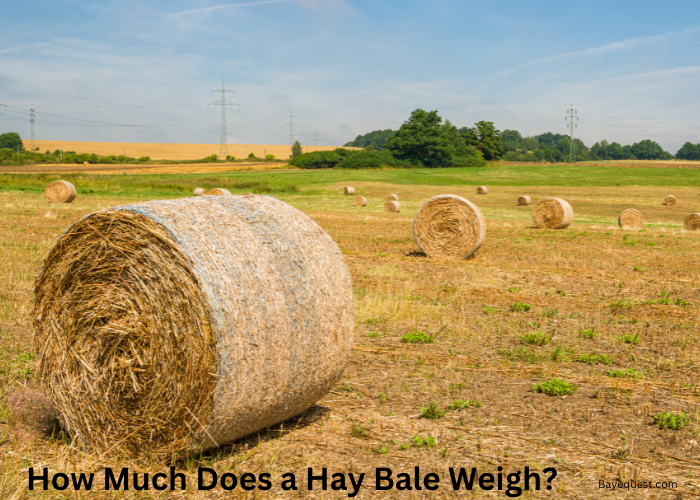Hay bales are a staple in farming, quietly playing a crucial role in feeding livestock and maintaining farms.
You’ll see them stacked high in barns or scattered across fields, but have you ever wondered: how much does a hay bale weigh?
The answer isn’t as simple as it seems. From lifting them onto trucks to feeding animals, knowing the weight of a hay bale can save time, effort, and even prevent injury.
Let’s break it down and uncover what determines the weight of these farmyard essentials.
What is Hay?
Hay is dried grass, clover, or other plants that farmers cut and store to feed their animals when fresh pasture isn’t around.
It’s like a pantry full of food for cows, horses, and sheep, keeping them well-fed during the winter or dry months.
Farmers carefully dry the plants to lock in the nutrients, so the hay stays fresh and nutritious for a long time. It’s a staple on any farm, making sure animals have plenty to eat, even when the fields are bare.
Without hay, keeping livestock healthy year-round would be a real challenge.
Read also: Difference Between Hay and Haylage.
Are Hay Bales the Same?
No, hay bales are not the same. They come in different shapes, sizes, and weights, depending on how they’re made and what they’re made from.
There are small square bales, big square bales, and round bales, each with its purpose and place on the farm. The type of hay inside—whether it’s alfalfa, timothy, or a mix—also makes a difference.
Some bales are lighter, easier to handle, and perfect for small farms, while others are heavy, packed tight, and designed for large operations.
So, when it comes to hay bales, one size doesn’t fit all.
What are the Different Types of Hay Bales?
Hay bales come in a variety of types, each designed for different farming needs.
Small square bales are the most common on smaller farms and for individual feeding.
These bales measure about 2 feet by 2 feet by 3-4 feet, or roughly 14-16 inches by 18 inches by 36-48 inches.
Large square bales are much bigger and are commonly found on large farms or commercial operations.
These bales generally measure around 3 feet by 3 feet by 8 feet or sometimes 4 feet by 4 feet by 8 feet.
Then there are round bales, which are often used on large-scale farms. Small round bales typically measure about 4 feet in diameter and 4 feet wide.
Large round bales, on the other hand, can be 5-6 feet in diameter and 4-5 feet wide.
Round bales are popular because they are efficient to produce and feed, especially when you need to feed large herds of livestock.
How Much Does a Bale of Hay Weigh?
The weight of a hay bale can vary quite a bit, depending on its size and type.
A small square bale usually weighs between 40 and 60 pounds, making it easy to handle by hand.
It’s the kind of bale you might see stacked in a barn or tossed into the back of a pickup truck.
Large square bales are a different story. These can weigh anywhere from 800 to 1,500 pounds.
They’re big, heavy, and require machinery to move around. You’ll often find these on larger farms where a lot of animals are fed at once.
Then there are round bales. A small round bale might weigh between 500 and 700 pounds.
But the larger ones, which can be 5 to 6 feet in diameter, can tip the scales at 1,200 to 2,000 pounds.
So, the weight of a hay bale depends on what type you’re dealing with.
One thing’s for sure—there’s a bale for every need, whether it’s a lightweight one for easy lifting or a massive one for serious feeding.
| Size of Hay Bale | Measurements | Weight (lbs) | Weight (kgs) |
| Small square bale | 2x2x3-4 feet (14-16x18x36-48 inches) | 40-60 lbs | 18-27 kg |
| Large square bale | 3x3x8 feet or 4x4x8 feet | 800-1500 lbs | 363-680 kg |
| Small round bale | 4 feet diameter by 4 feet wide | 500-700 lbs | 227-318 kg |
| Large round bale | 5-6 feet diameter by 4-5 feet wide | 1200-2000 lbs | 544-907 kg |
How Much Do Round Hay Bales Weigh?
A round bale’s weight can vary depending on its size.
Small round bales usually weigh between 500 and 700 pounds, which is about 227 to 318 kilograms.
These bales are easier to manage and might be used on smaller farms or for feeding fewer animals.
Large round bales can be much heavier, ranging from 1,200 to 2,000 pounds, or 544 to 907 kilograms.
These bales are commonly used on larger farms where you need to feed a lot of livestock at once.
Because of their size and weight, they require machinery to move around.
| Size of Round Bale | Measurements | Weight (lbs) | Weight (kgs) |
| Small round bale | 4 feet diameter by 4 feet wide | 500-700 lbs | 227-318 kg |
| Medium round bale | 5 feet diameter by 4-5 feet wide | 800-1,200 lbs | 363-544 kg |
| Large round bale | 6 feet diameter by 5 feet wide | 1,200-2,000 lbs | 544-907 kg |
Square/Rectangular Hay Bale Weights and Sizes
The weight of a square bale depends on how it’s made. Two-string square hay bales are the lighter ones you often see stacked in barns.
They usually weigh between 40 and 60 pounds, which makes them easy to lift and handle by hand. These are great for smaller farms or individual feeding.
Three-wire square hay bales are a bit heftier. They weigh around 100 to 140 pounds.
These bales are tightly packed and require a bit more muscle to move. You might see these on larger farms where feeding efficiency is important.
Then there are high-density square hay bales. These are the big boys, weighing anywhere from 1,200 to 1,500 pounds.
These bales are densely packed and require machinery to handle. They’re used in large-scale operations where moving a lot of hay quickly is key.
So, whether it’s a two-string, three-wire, or high-density bale, the weight varies, but each type serves a specific purpose on the farm.
| Type of Square Bale | Weight (lbs) | Weight (kgs) |
| Two-string Square Hay Bale | 40-60 lbs | 18-27 kg |
| Three-wire Square Hay Bale | 100-140 lbs | 45-64 kg |
| High-density Square Hay Bale | 1,200-1,500 lbs | 544-680 kg |
How Much Do Small Hay Bales Weigh?
Small hay bales generally refer to two-string square bales or small round bales.
For two-string square bales, the weight typically ranges from 40 to 60 pounds, which is about 18 to 27 kilograms.
These are the most common small bales you’ll find, easy to handle, and often used in smaller farming operations or for individual animal feeding.
When it comes to small round bales, they usually weigh a bit more, ranging from 500 to 700 pounds, or about 227 to 318 kilograms.
These bales are still manageable but usually require some equipment to move around.
So, small hay bales can weigh anywhere from 40 to 700 pounds, depending on their shape and how they’re made.
How Much Do Large Square Hay Bales Weigh?
Large square hay bales are heavier than their smaller counterparts. These bales typically come in dimensions like 3 feet by 3 feet by 8 feet or 4 feet by 4 feet by 8 feet.
The weight of these bales usually ranges from 800 to 1,500 pounds, or about 363 to 680 kilograms.
These bales are tightly packed and require machinery to move them around. They’re commonly used in larger farming operations where feeding a lot of livestock efficiently is crucial.
The heavyweight and dense packing of these bales make them ideal for big farms that need to store and distribute large amounts of hay.
Bale of Hay Weight
Hay comes in different types, each with its weight range, depending on the plant used and how it’s baled.
Grass hay, like Timothy and Bermuda, usually weighs 40-60 pounds for small square bales and 1,200-2,000 pounds for large round bales.
Now much does a bale of alfalfa weigh? Alfalfa hay weighs around 50-70 pounds for small square bales and 1,200-1,800 pounds for large round bales.
Mixed hay, which blends grasses and legumes, varies in weight but generally falls between grass hay and alfalfa hay.
Clover hay, another protein-rich option, weighs similarly to alfalfa, with small square bales at 40-60 pounds and large round bales at 1,200-1,800 pounds.
Each type of hay has its specific weight and use, making it important to choose the right one for your livestock’s needs.
Interesting read: Is Bermuda Hay Good for Horses?
Factors that Impact Hay Bale’s Weight
When it comes to hay bales, their weight isn’t just a number; it’s influenced by several key factors.
Let’s break down the main factors that determine just how heavy that bale in your field or barn will be.
Plant species
Plant species play a big role in how much a hay bale weighs. Different plants have different densities.
For example, alfalfa is denser and heavier than timothy grass. So, a bale made from alfalfa will weigh more than a bale of the same size made from lighter grass.
Moisture content
Moisture content can also impact the weight of a hay bale. When hay is baled, if it has too much moisture, it will be heavier.
Dry hay is lighter. The more moisture in the bale, the more it will weigh.
This is why farmers aim for the right moisture level to ensure the hay is not too heavy and stays preserved longer.
Density
Density matters too. How tightly the hay is packed affects the bale’s weight.
A bale that is packed more tightly will weigh more because there’s more material in a smaller space.
Loose bales are lighter because there’s more air and less hay.
Bale size and shape
Bale size and shape are other factors. A larger bale will naturally weigh more because it contains more hay.
The shape, whether it’s round or square, also impacts the weight. Round bales tend to be heavier because they are usually made larger, while smaller square bales are lighter and easier to handle.
Round Vs Rectangular Bales
When choosing between round and rectangular hay bales, you need to understand their differences.
Each type has its advantages, from how easily they can be handled to how efficiently they can be stored.
Let’s dive into the key differences between round and rectangular bales.
| Feature | Round bales | Rectangular bales |
| Shape | Round | Rectangular |
| Common sizes | 4-6 feet in diameter, 4-5 feet wide | 2x2x3-4 feet for small, 3x3x8 or 4x4x8 feet for large |
| Weight range | 500-2,000 lbs (227-907 kg) | 40-1,500 lbs (18-680 kg) |
| Ease of handling | Requires machinery for handling | Small bales are easy to handle manually; large bales require machinery |
| Storage efficiency | Less efficient, can take up more space | More efficient, stacks neatly |
| Equipment required | Tractor with a bale spear or similar equipment | Small bales can be handled by hand, large bales need machinery |
| Common use | Large-scale livestock feeding | Small farms or large-scale operations, depending on size |
Why Hay Bale Weight Matters
Hay bale weight matters for a few important reasons.
First, it affects how much hay you’re getting. Heavier bales mean more feed for your animals, and that’s key when you’re planning how much you need to buy or store.
It also impacts how you handle and transport the bales. Lighter bales can be moved by hand, but heavier ones require machinery, which adds to your workload and costs.
The weight also plays a role in feeding efficiency. Knowing the weight helps you ration out the right amount of hay, ensuring your animals get what they need without wasting any.
Finally, it’s crucial for storage. Heavier bales take up more space and might require stronger structures to hold them.
So, the weight of a hay bale isn’t just a number; it’s a factor that touches almost every part of managing a farm.
How to Weigh a Hay Bale
Weighing a hay bale isn’t as tricky as it might seem, but it’s important to get it right. Here’s how you can do it:
For small bales, you can use a simple scale. If you have a bathroom scale or a portable livestock scale, just set the bale on it and read the weight.
Make sure to balance the bale properly on the scale so you get an accurate reading.
For larger bales, like big square or round ones, you’ll need something more robust. A platform scale is ideal.
These scales are designed to handle heavy loads. Place the bale on the platform, either with machinery like a tractor or by rolling it on, and get your reading.
If you don’t have a scale, you can estimate the weight using some basic math. Measure the bale’s dimensions and use the average weight for that type of bale.
For example, if you know a bale of a certain size usually weighs 1,200 pounds, and your bale is similar, that’s a good ballpark figure.
In a pinch, you can also use a bale spear with a built-in scale. This tool attaches to your tractor and gives you a weight reading as you lift the bale.
It’s not as precise as a platform scale, but it’s quick and gets the job done.
How Much Does a Bale of Hay Cost?
The cost of a bale of hay can vary widely depending on the type and quality of the hay. On average, the price for one ton (2,000 pounds) of hay provides a good benchmark.
Grass hay costs between $100 and $200 per ton. This type of hay is commonly used for feeding livestock and is generally more affordable.
Alfalfa hay, which is richer in nutrients and often preferred for feeding dairy cattle and horses, tends to be more expensive.
It costs between $150 and $300 per ton or even higher, depending on the quality.
Mixed hay, which is a combination of different grasses and sometimes alfalfa, falls somewhere in between.
These prices can fluctuate based on factors like location, season, and availability, so it’s always a good idea to check current market rates.
Related read: How Many Bales of Hay Per Acre?
How Much Does a Hay Bale Weigh? Conclusion
So, whether you’re lifting, stacking, or feeding, knowing how much a hay bale weighs can save you a lot of sweat and guesswork.
It’s not just about numbers on a scale. It’s about making sure your animals are well-fed, your equipment is up to the task, and your storage space isn’t bursting at the seams.
Next time you grab that bale, you’ll have a better idea of what you’re dealing with, and that’s half the battle won.








